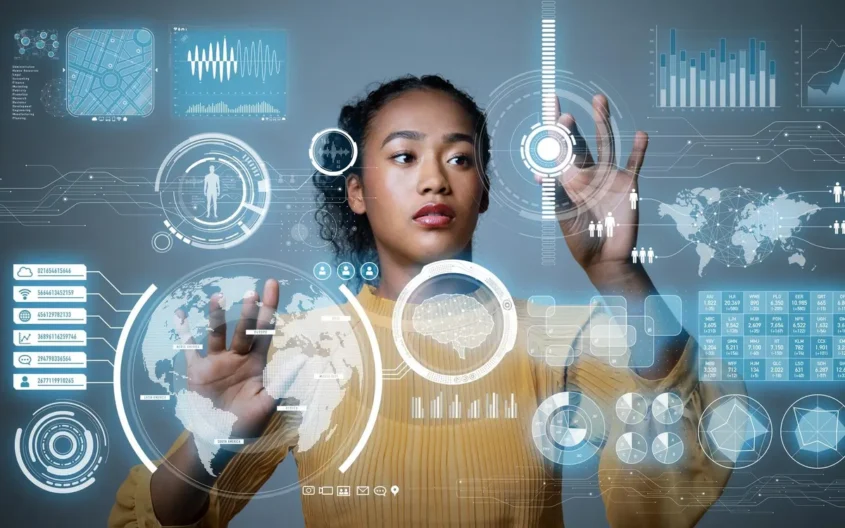Must-Know AI Technologies That Are Shaping the Future of Work

Must-Know AI Technologies That Are Shaping the Future of Work
The rapid advancement of Artificial Intelligence (AI) technologies has begun to reshape the future of work across various industries. From automation and machine learning to natural language processing and robotics, AI is revolutionizing the way tasks are executed, decisions are made, and communication is conducted in the workplace.
As organizations strive to stay competitive and efficient in an increasingly digital world, understanding the must-know AI technologies and their implications becomes crucial. This article explores the key AI technologies that are shaping the future of work, their applications, benefits, and the ethical considerations and challenges that accompany their adoption.
Discover the groundbreaking AI technologies that are revolutionizing industries and shaping the future. From machine learning to natural language processing, explore the must-know advancements that are driving innovation and transforming the way we live and work. Stay ahead of the curve and gain insights into the AI technologies that are shaping the future of technology.
1. Introduction: The Evolution of AI Technologies in the Workplace
The Rise of AI in the Workplace
Remember when AI was just a thing of sci-fi movies? Well, fasten your seatbelt because it’s now becoming a reality in the workplace. AI technologies are rapidly evolving and making their way into various industries, revolutionizing how we work and giving us a glimpse into the future.
Key Drivers Behind the Adoption of AI Technologies
So why are businesses hopping on the AI bandwagon? Well, several factors are driving the adoption of AI technologies. First, there’s the promise of increased efficiency and productivity. AI-powered automation can take over repetitive tasks, freeing up time for employees to focus on more strategic and creative endeavors.
Moreover, AI technologies like natural language processing and machine learning are enabling better customer service and decision-making, leading to improved business outcomes. Finally, let’s not forget the allure of staying ahead of the competition. In an increasingly digital world, integrating AI technologies is becoming a necessity rather than a luxury for businesses looking to remain relevant.
2. AI-Powered Automation: Transforming Task Execution and Efficiency
The Role of AI in Automating Repetitive Tasks
Raise your hand if you’ve ever found yourself drowning in endless spreadsheets or drowning in mundane tasks. Well, fear not, because AI is here to save the day (or at least your sanity). AI-powered automation is revolutionizing the way tasks are executed in the workplace. From data entry and report generation to inventory management and customer support, AI algorithms can take over these repetitive tasks, allowing humans to focus on more complex and creative work. Consider it a digital assistant that never needs coffee breaks or vacations.
Improving Productivity and Accuracy through AI Automation
Not only does AI-powered automation free up time, but it also improves productivity and accuracy. Machines don’t get tired or distracted, meaning they can churn out work at lightning speed while minimizing errors. This newfound efficiency can have a significant impact on business operations, resulting in cost savings, faster turnaround times, and happier customers (who doesn’t love accurate and speedy service?).
3. Natural Language Processing: Revolutionizing Communication and Customer Service
Understanding the Basics of Natural Language Processing (NLP)
Ever wondered how your voice commands magically translate into actions on your smart devices?
From voice assistants to chatbots, NLP is transforming how we communicate and seek information. It’s like having a language prodigy at your service 24/7.
Enhancing Customer Interactions with AI-Powered Chatbots
Gone are the days of waiting on hold for customer support or scrolling endlessly through FAQs. AI-powered chatbots are taking over the customer service game. These virtual assistants can provide instant and personalized responses to customer queries, making interactions faster and more efficient. Plus, they never get grumpy (unless programmed to be sassy), ensuring a consistently positive customer experience. So next time you’re chatting with a customer service representative, don’t be surprised if you’re talking to a chatbot who’s acing the Turing test.

4. Machine Learning: Enhancing Decision-Making and Predictive Analysis
How Machine Learning Algorithms Improve Decision-Making
If you think AI is all fun and games, think again. Machine learning, a subfield of AI, is all about making sense of data and using it to make better decisions. Machine learning algorithms can analyze vast amounts of data, identify patterns, and make predictions or recommendations based on that analysis.
This means that businesses can leverage machine learning to optimize decision-making processes, whether it’s predicting customer behavior, identifying market trends, or optimizing supply chain logistics. So instead of relying on gut feelings or crystal balls, we can now make data-driven decisions (hooray for logic!).
Utilizing Predictive Analysis to Optimize Business Strategies
Predictive analysis, powered by machine learning, is like having a crystal ball that works (bye-bye, dubious fortune tellers). By analyzing historical data and patterns, predictive analysis algorithms can forecast future outcomes, helping businesses optimize their strategies.
From predicting product demand and customer churn to optimizing pricing and marketing campaigns, the possibilities are endless. So next time you’re strategizing for your business, don’t forget to consult your AI crystal ball for some insider information.
5. Robotics and Autonomous Systems: Revolutionizing Manufacturing and Logistics
The Integration of Robotics in Manufacturing Processes
Robots are no longer just a sci-fi fantasy—they have become an integral part of modern manufacturing. With advancements in robotics technology, companies are utilizing robots to automate repetitive and dangerous tasks on assembly lines. These robots work tirelessly and with precision, leading to increased productivity and improved product quality. Plus, with robots taking on these tasks, human workers can focus on more complex and creative aspects of production.
The Role of Autonomous Systems in Logistics and Supply Chain
The logistics and supply chain industry is also experiencing a revolution thanks to autonomous systems. With the integration of AI technology, autonomous vehicles are taking over the roads, optimizing delivery routes, and reducing transportation costs. Furthermore, unmanned drones are being deployed for efficient inventory management and last-mile deliveries. These autonomous systems are not just streamlining operations but also improving safety and reducing human error.
6. Computer Vision: Enabling Advanced Image and Video Analysis
Understanding the Capabilities of Computer Vision Technology
Computer vision, an AI technology, allows machines to analyze and understand visual information, much like humans do. By harnessing the power of computer vision, machines can perceive, interpret, and respond to images and videos. This technology enables tasks such as object recognition, facial recognition, and even autonomous driving. With computer vision, industries can automate processes that rely on visual analysis, leading to better decision-making and increased efficiency.
Applications of Computer Vision in Various Industries
Computer vision finds applications in numerous industries. In healthcare, it aids in medical imaging analysis and assists in diagnosing diseases. In security and surveillance, it helps identify potential threats and suspicious activities. The scope of computer vision is vast, and its implementation has the potential to transform how we interact with technology across various sectors.
7. AI-Powered Virtual Assistants: Streamlining Administrative Tasks and Workflow
The Benefits of AI Virtual Assistants in the Workplace
Gone are the days of juggling multiple tasks and drowning in administrative work. AI-powered virtual assistants, such as chatbots and voice assistants, are here to streamline the workflow. These intelligent assistants can handle repetitive and time-consuming tasks like scheduling meetings, answering customer queries, and managing data. By delegating these tasks to AI virtual assistants, employees can focus on higher-value work, leading to increased productivity and job satisfaction.
Improving Efficiency with AI-Assisted Administrative Tasks
AI-assisted administrative tasks not only save time but also reduce errors. Virtual assistants can analyze data, generate reports, and even collaborate with team members. Additionally, they can personalize user experiences by learning from user interactions and preferences. With AI taking over administrative duties, organizations can achieve greater efficiency, improved accuracy, and seamless collaboration.
8. Ethical Considerations and Challenges in Adopting AI Technologies in the Workplace
Addressing Ethical Concerns in the Integration of AI Technologies
As AI technologies become more prevalent in the workplace, ethical concerns arise. Organizations must ensure they adhere to ethical guidelines and regulations to protect user data and prevent discriminatory practices. Transparency and accountability are crucial when implementing AI technologies to maintain trust and mitigate potential ethical risks.
The Challenges of Implementing AI in the Workplace
Adopting AI technologies in the workplace comes with its own set of challenges. Companies need to invest in infrastructure and resources to integrate these technologies seamlessly. Furthermore, there may be resistance to change from employees who fear job loss or lack the necessary skills to adapt. Overcoming these challenges requires effective change management, upskilling programs, and fostering a culture that embraces technological advancements. By addressing these obstacles, organizations can successfully navigate the integration of AI technologies and reap the benefits they offer.
Conclusion
In conclusion, the transformative power of AI technologies in the workplace cannot be underestimated. From streamlining tasks and improving efficiency to enabling advanced analysis and decision-making, AI is revolutionizing the way we work. However, as with any disruptive technology, ethical considerations and challenges must be carefully addressed to ensure responsible and sustainable integration. By embracing these must-know AI technologies and navigating the associated complexities, organizations can unlock new opportunities, enhance productivity, and position themselves for success in the evolving landscape of work.
FAQ
1. How can AI-powered automation benefit my workplace?
AI-powered automation can benefit workplaces by taking over repetitive, mundane tasks, freeing up human employees to focus on more strategic and high-value work. It can significantly improve task execution efficiency, reduce errors, and increase overall productivity.
2. What are some key considerations when adopting AI technologies in the workplace?
When adopting AI technologies, it is important to consider factors such as data privacy and security, ethical implications, potential job displacement, and the need for upskilling and reskilling the workforce. A well-thought-out strategy that addresses these considerations is essential for successful integration and mitigating potential challenges.
3. How can natural language processing (NLP) revolutionize communication and customer service?
NLP enables machines to understand and interpret human language, allowing for advanced communication capabilities. It can revolutionize customer service by enabling AI-powered chatbots and virtual assistants to provide personalized and efficient support, streamline communication channels, and enhance overall customer experience.
4. What are the potential risks associated with the integration of AI technologies in the workplace?
Some potential risks of integrating AI technologies in the workplace include biases in algorithms, unintended consequences, job displacement, and concerns about data privacy and security. It is important for organizations to proactively address these risks and ensure they have proper governance and ethical frameworks in place to mitigate potential negative impacts.
Thank you for reading 🙂











